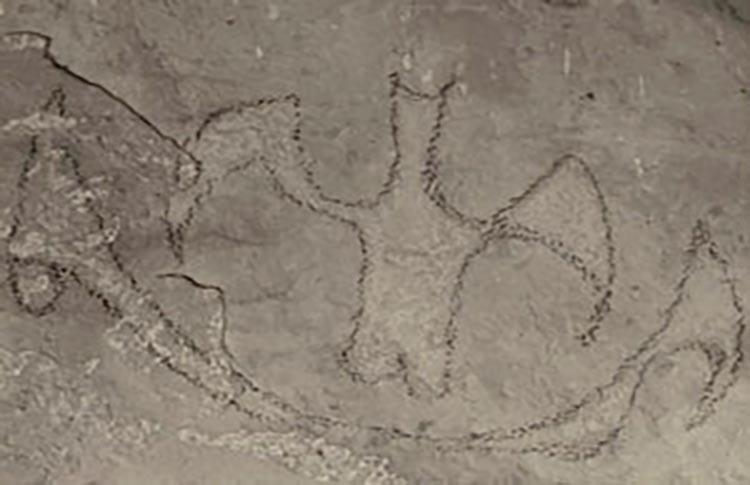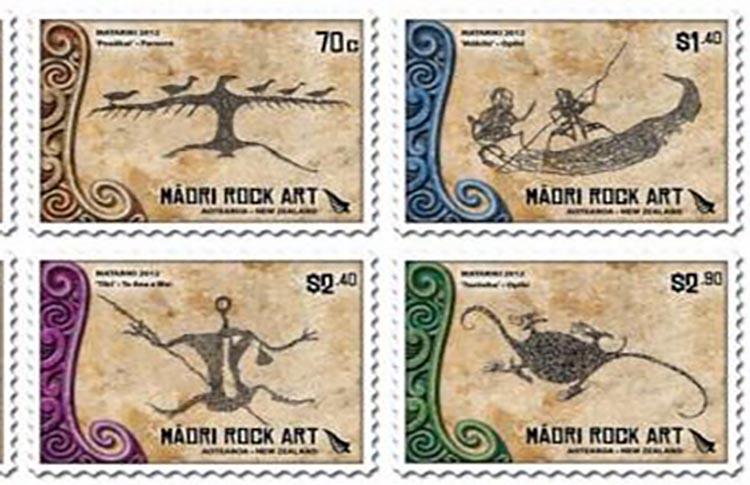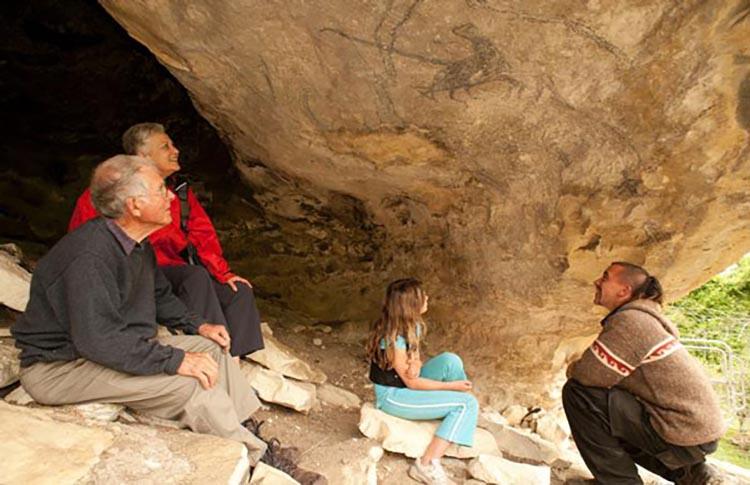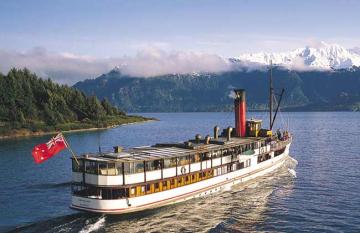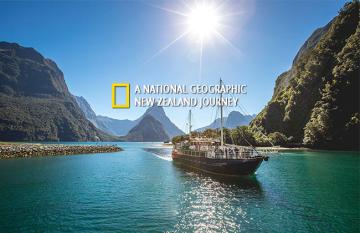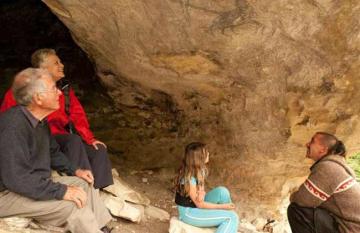
In the prehistoric age, nomadic Maori hunters created New Zealand’s earliest surviving artwork - This Maori Rock Art opens a rare window to our distant past.
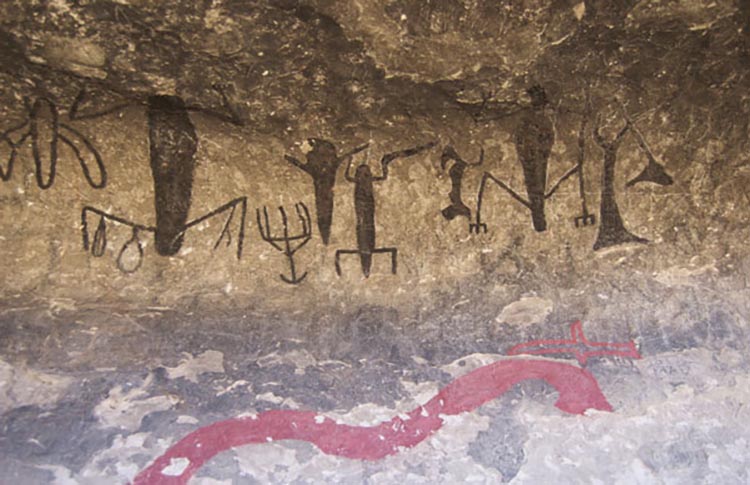
Contents
Prehistoric New Zealand
In the prehistoric age of early human occupation, nomadic Maori hunters created New Zealand’s earliest surviving artworks in caves and shelters as long ago as the fifteenth century or earlier, The Maori Rock Art is admired by archaeologists and historians alike, these windows on the past show a strength and elegance of design but the question of origin and significance are still a mystery.
Located in the South Island
With few exceptions, these ancient sites are found in New Zealand's South Island, particularly in the limestone areas of South Canterbury and North Otago - It's here that you'll find some of our oldest signs of our human occupation. Rock art is the oldest surviving artistic medium with drawings starting to appear with the first wave of people into the South Island between 600 and 1000 years ago. This is now known as the ‘Moa Hunter’ period, a time when almost all of the country was heavily forested and especially around where the rock drawings are now found. These forested areas harbored abundant food supplies including a number of species of the now extinct large Moa.
Nomadic Existence
The Hunters lived a nomadic or 'hunter-gatherer' existence, unlike their village dwelling descendants, and lead regular expeditions into the interior of the South Island taking with them basic stone tools and a certain amount of food. Sheltering under rock overhangs, mostly of limestone, building fires and eating the food they had brought as well as cooking what they had gathered. It was during these stay-over’s that they drew, initially using charcoal from their fires and then red ochre or hematite (Iron Oxide) - This latter pigment does not occur naturally in most rock art areas and must have been brought in deliberately Although it is impossible to know their intent, it is thought the early motive to draw was purely functional, to make ‘‘spatial markers'' or in other words, road signs. People walking the land, looking for food and finding food create a story in images for a specific area to help them remember. It is thought the markers were gradually elaborated on to depict local mythology and perhaps the ancestry of the sites visitors.
What did the art depict?
Birds and fish are commonly seen on the walls (New Zealand only has one Native mammal, a small bat) with humans being the most prevalent of all the recognizable objects. Some forms are not readily identifiable and some represent mythical monsters or Maori legend such as the Taniwha or distant memories of creatures from another land. Rarely are the drawings realistic, mostly the shapes are stylized sometimes to such a degree that accurate identification can become impossible or even questionable – but this is the true nature of the process art is it not?
Then it stopped...
Then all of a sudden between 700 and 400 years ago, most of the east coast forests were destroyed in a series of huge, man made fires. The exact reason is heavily debated and will never be known. What is known is that the fires resulted in a razing of the habitat of many of the birds. A number of species including all the Moas became extinct. The areas formerly favored for hunting and where many of the rock shelters occur, became barren and inhospitable. There was no longer any reason to visit those areas and they were largely abandoned for many centuries, along with the practice of rock art.
Worth a Visit
The smooth walls of limestone outcrops in South Canterbury and North Otago provided an ideal canvas for early Māori and although over 500 years old, many of the rock drawings have survived the elements and can be clearly seen. Found at more than 550 sites and with a high probability that more lie hidden waiting to be found, more than 95 per cent of the art is located on private land and thus are rarely visited.
Unfortunately the natural “exfoliation” of the limestone has ment many of the drawings are in an advanced state of degradation. Although they may not be able to boast the longevity of the Australian Aboriginals rock drawing, which dates back more than 50,000 years, the Maori rock art is no less significant and provides a fascinating record of early Maori occupation and displays a continuum that extends from moa-hunting to European contact.
The drawings all have a perceivable cultural similarity and show a wide range of artistic ability ranging from doodles to well executed, artistically balanced figures.
The difference between Maori rock drawings and the better-known wood carvings is not just a matter of a different medium. They were done many centuries before most of the known woodcarvings in a very different cultural period.
Get into the field with a local guide
With 550-recorded sites, 250 of those within an hour of Timaru, it is perfect for those traveling from Christchurch to Lake Tekapo, Mt Cook or Queenstown to stop for a guided tour.
If you want to get into the field and see some of the more significant examples of Maori rock art, contact us and we can arrange a knowledgeable local Maori whom will not only explain the mystery of the drawings but also give you an insight into the local tribal stories and traditions. Let First Light Travel create your holiday of a lifetime.
Recent Posts
Blog Categories
Blog archives
- July 2024 (2)
- May 2024 (12)
- April 2024 (2)
- March 2024 (2)
- January 2024 (2)
- November 2023 (10)
- October 2023 (4)
- August 2023 (1)
- May 2023 (2)
- April 2023 (2)
- March 2023 (17)
- February 2023 (4)
- January 2023 (4)
- December 2022 (11)
- November 2022 (7)
- October 2022 (1)
- May 2022 (1)
- March 2022 (3)
- February 2022 (3)
- January 2022 (1)
- December 2021 (1)
- August 2021 (1)
- June 2021 (1)
- May 2021 (2)
- February 2021 (1)
- August 2020 (1)
- July 2020 (1)
- May 2020 (1)
- April 2020 (1)
- March 2020 (1)
- January 2020 (1)
- December 2019 (1)
- November 2019 (1)
- October 2019 (1)
- September 2019 (1)
- August 2019 (5)
- July 2019 (2)
- June 2019 (1)
- May 2019 (3)
- April 2019 (1)
- March 2019 (1)
- February 2019 (1)
- January 2019 (1)
- December 2018 (1)
- November 2018 (1)
- September 2018 (1)
- August 2018 (1)
- July 2018 (1)
- June 2018 (1)
- May 2018 (1)
- April 2018 (1)
- March 2018 (1)
- February 2018 (1)
- January 2018 (1)
- December 2017 (1)
- October 2017 (1)
- September 2017 (1)
- August 2017 (1)
- July 2017 (1)
- June 2017 (1)
- May 2017 (1)
- April 2017 (1)
- March 2017 (1)
- February 2017 (1)
- January 2017 (1)
- December 2016 (1)
- November 2016 (1)
- October 2016 (1)
- September 2016 (1)
- August 2016 (1)
- July 2016 (1)
- June 2016 (1)
- May 2016 (1)
- April 2016 (1)
- March 2016 (1)
- February 2016 (1)
- January 2016 (1)
- December 2015 (1)
- November 2015 (1)
- October 2015 (1)
- September 2015 (1)
- August 2015 (1)
- July 2015 (1)
- June 2015 (1)
- May 2015 (1)
- April 2015 (1)
- March 2015 (1)
- February 2015 (1)
- January 2015 (1)
- December 2014 (1)
- November 2014 (1)
- October 2014 (1)
- September 2014 (1)
- July 2014 (1)
- June 2014 (3)
- May 2014 (1)
- April 2014 (1)
- March 2014 (1)
- February 2014 (1)
- January 2014 (1)
- November 2013 (15)
- October 2013 (1)
- September 2013 (1)
- August 2013 (1)
- July 2013 (1)
- May 2013 (1)
- April 2013 (1)
- March 2013 (1)
- February 2013 (1)
- January 2013 (1)
- December 2012 (1)
- November 2012 (2)
- October 2012 (2)
- September 2012 (2)
- August 2012 (2)
- July 2012 (2)
- June 2012 (2)
- May 2012 (2)
- April 2012 (3)
- March 2012 (2)
- February 2012 (2)
- January 2012 (2)
- December 2011 (2)
- November 2011 (1)
- October 2011 (2)
- September 2011 (1)
- August 2011 (1)
- July 2011 (1)
- June 2011 (1)
- May 2011 (1)
- April 2011 (1)
- March 2011 (1)
- February 2011 (1)
- January 2011 (1)
- December 2010 (1)
- November 2010 (1)
- October 2010 (1)
- September 2010 (1)
- August 2010 (1)
- July 2010 (1)
- June 2010 (1)
- May 2010 (1)
- March 2010 (1)
- February 2010 (1)
- January 2010 (1)
- December 2009 (1)
- November 2009 (1)
- October 2009 (1)
- September 2009 (1)
- August 2009 (1)
- July 2009 (1)
- June 2009 (1)
- May 2009 (1)
- April 2009 (1)
- March 2009 (1)
- February 2009 (1)
- January 2009 (1)
- December 2008 (1)
- May 2005 (1)


